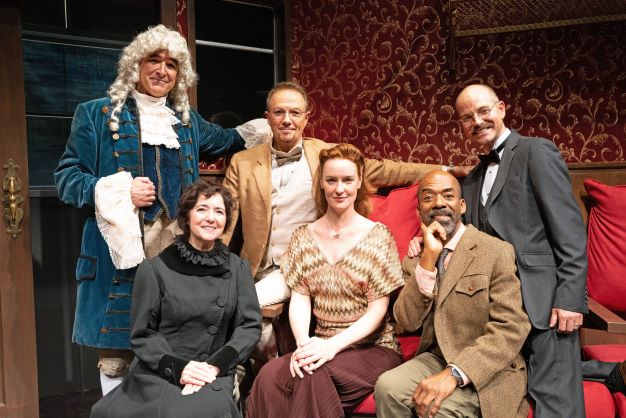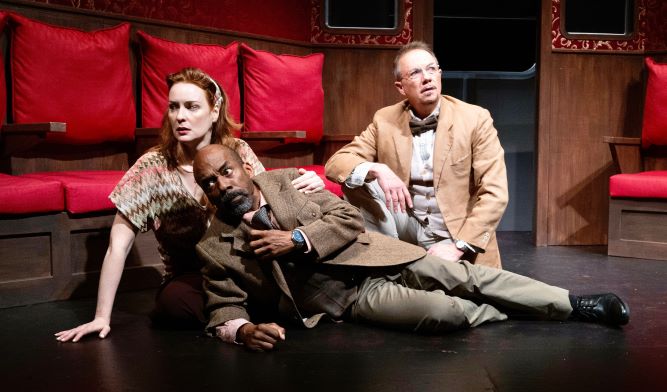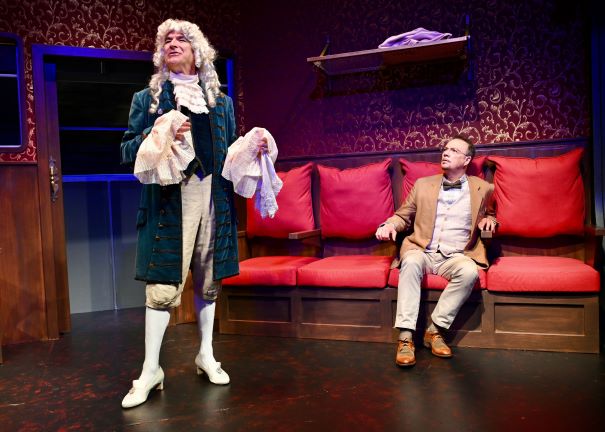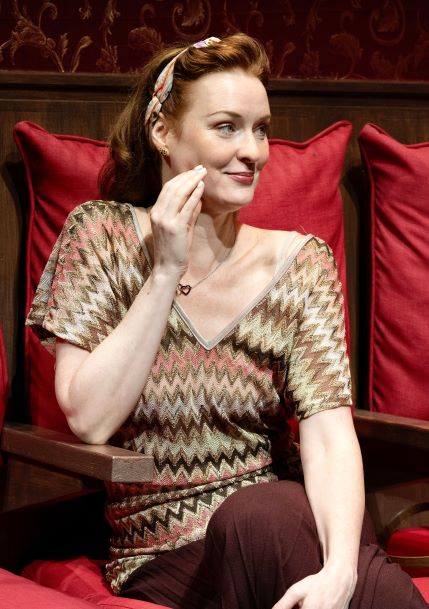“Strings Attached” is about three physicists, an American woman and two British men, on their way by train from Cambridge to London to see Michael Frayn’s science-based play “Copenhagen.” June (Robyne Parrish) is married to George (Paul Schoeffler) while also in an affair with Rory (Brian Richardson). En route, June recalls a tragic event from a past train trip, and there are interruptions by fellow travelers, a couple from America and one from Ukraine (presumably pre-Russian invasion).
Also, each physicist is visited by the ghost of an historically significant scientist: June by two-time Nobel Laureate (2003 in Physics and 2011 in Math) Marie Curie (Bonnie Black); 1918 Nobelist, German theoretical physicist Max Planck (Russell Saylor), appears to Rory; and Isaac Newton (Jonathan Hadley), whose 17th Century career pre-dated the 1901 Nobel inaugural, to George. And all that is in the first act.Act two repeats the start of act one with the same train-boarding scene and dialogue. But the devil is in the details, as is said. The trio’s marriage and extra-marital situations are scrambled, as is the traumatic recollection. Thus is established the Parallel Universe concept. My clumsy take on it: We exist only as we are observed at any given point in multiple dimensions of time and space. It is a fascinating notion, which “Strings Attached” playwright Carole Buggé adopts as a starting point for her equally fascinating play, running through October 1 at Theatre Row. (Thanks to Buggé, I now know it was a falling peach, not an apple, that alerted Newton to the force of gravity. Live and learn.)
Under Alexa Kelly’s smooth direction, the fluid relationships are always clear; her blocking alone on Jessica Parks’s set is outstanding. The playwright allows that “the set requirements are minimal” and can be just “four chairs on a stage,” but you do not engage designer Parks to just, um, park four chairs on a stage. Her train compartment is more spacious and grander than an actual one, allowing for the movement and seating configurations that director Kelly manipulates so well. It is a beaut.
The metaphysics of time and space, and how the relatively recent M Theory expands upon String Theory and rebuts the Big Bang, are semi-explained in excessive jargon. One charted illustration of a Planck theorem, explained first by Planck and expanded upon by June, is way too academic, and some other exchanges are also challenging. That noted, the play is, at its heart, a romantic triangle, a dramady with tones of grief, deception and loss.
There is also a good amount of humor. A joke about how many physicists it takes to screw in a light bulb is paraphrased a few times, each one funnier than the last. And it turns out that Isaac Newton is a particularly witty fellow. (Who knew?) Among the litany of wishes June, Rory and George rap about, besides truth and goodness and eternal life, are a really effective deodorant, really good ice cream, and multiple orgasms. (Quantum physics can only do so much.)
The excellent acting is all of a piece; discrete characters, to be sure, but on the same wavelength – or, in keeping with the theme, on parallel wavelengths. June is a fulcrum between her two traveling companions; her affection for both is constant, even as her alliances with them shifts during intermission. Parrish plays both the constancy and the swing with apparent ease. Smashing in a flowing, earth tone pants outfit (Elena Vannoni’s costumes are spot-on), her June mediates and consoles without favor. Strong, clever women handle awkward situations well, assure the author, director, and actor.
The men are no less effective. George is a stuffy, stoic chap, whose emotions are nonetheless exposed in Schoeffler’s perceptive reading. Rory is quicker to anger, to take the bait; Richardson adeptly captures his passion for scientific inquiry – and for June. Hadley, Black and Saylor evoke the historical figures (and the Ukrainian and American couples) without undue exaggeration.

From left: Jonathan Hadley, Bonnie Black, Paul Schoeffler, Robyne Parrish, Brian Richardson, Russell Hadley
At one point, surprised at the long run of “Copenhagen,” the play they’ll see in London, George wonders “Who wants to see a play about physics?” You may feel the same, but put that aside for a play in which physical science and human relationships, despite being on parallel lines, do meet up in the end. With shout-outs to “The Sound of Music” and “Oliver,” and snippets of the poetry of Blake, Yeats and T. S. Eliot, “Strings Attached” is one of the smartest plays on a current New York stage.
Through October 1 at Theatre Row, 410 West 42nd Street. For Wed – Sun performance schedule and tickets: www.stringsattached-offbroadway.org




